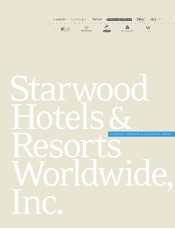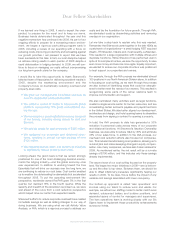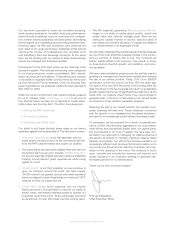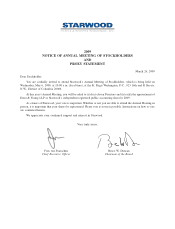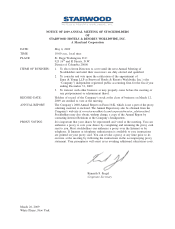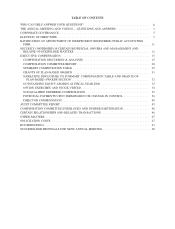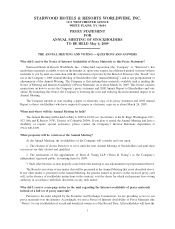Starwood 2008 Annual Report Download - page 4
Download and view the complete annual report
Please find page 4 of the 2008 Starwood annual report below. You can navigate through the pages in the report by either clicking on the pages listed below, or by using the keyword search tool below to find specific information within the annual report.
Our top-down approach is known as normative modeling,
which employs analytics to ‘normalize’ hotel cost performance-
based structural variables, such as room size and configura-
tion, number of service elevators, and unionization. Normalizing
further assists us in identifying top performing hotels and per-
formance gaps. As with lean operations, best practices are
then rolled out to under-performers. Examples of this include
reducing the number of housekeepers per occupied room
and simplifying food and beverage concepts. At the same
time, we are working with our owners to share these savings
across the managed and franchised system.
Procurement is the third area where we are reducing costs
across the system. This includes introducing more categories
to our buying programs, vendor consolidation, SKU rational-
ization and improved compliance. These efforts have resulted
in the ability to negotiate better contract terms for items such
as food, flat screen TVs and laptops. Given our success from
recent negotiations, we anticipate additional direct savings of
$35 million in 2009.
While the current environment has created intense pressure
for us to manage costs, controlling our costs is just one of
four financial levers we have at our disposal to create share-
holder value over the long-term. The other three levers are:
• Driving RevPAR premiums
• Growing our pipeline
• Unlocking real estate value
Our ability to pull these financial levers relies on our team’s
execution against the five essentials of “The Starwood Journey.”
1. ‘Starwood Class Brands’ is our first essential, and our
brand teams are hard at work on the innovations that will
drive RevPAR outperformance and propel our pipeline.
2. The brand teams are also better aligned than ever with our
Operations team as we work towards ‘Brilliant Execution,’
our second essential. Brilliant execution means consistently
creating brand-relevant guest experiences while being
vigilant on costs.
3. ‘Global Growth’ is our third essential, and we continue to
grow our footprint around the world. We have roughly
100,000 rooms in our pipeline, and our brand and operations
teams are aligned to open these hotels on-brand and ‘HOT,’
meaning on time, on budget and full.
4. ‘Great Talent’ is our fourth essential, and our Human
Resources team is driving efforts to improve our ability to
attract, retain, and develop talented people to operate our
properties around the world. This is particularly important
as we still plan to open 425 hotels over the coming years.
5. The fifth essential, generating ‘Market-Leading Returns,’
hinges on our ability to realize global growth, unlock real
estate value, and carefully manage costs. While we are
waiting for capital markets to recover, selective sales of
real estate and prudent allocation of capital will advance
our transformation to an asset-light model.
We have often described the branded global hotel fee business
as one of the most attractive business models in the world—
and we continue to believe this is true. The contracts are
stable, capital-efficient and long-term. Fee growth is driven
by three factors: RevPAR growth, unit additions, and incen-
tive escalation.
We have made substantial progress over the last few years in
growing our managed and franchised business and reducing
the size of our owned portfolio. Today, 53% of our EBITDA
contribution is from fee income, up from 18% five years ago.
Our goal is to be over 80% fee-driven in the coming years. By
itself, this focus on the fee business will result in a sustainable
growth engine that throws off significant free cash flow. At the
same time, our balance sheet holds more opportunities to
generate cash, in the form of real estate at our owned hotels
and inventory at the vacation ownership business.
Reducing the size of our owned portfolio and vacation own-
ership business will take time. These initiatives—combined
with the growth in our managed and franchised business—
will result in an increasingly capital-efficient business model.
To summarize, we are prepared for a variety of potential sce-
narios in 2009. We have been aggressive in our cost contain-
ment efforts and dramatically scaled back our capital plans,
but are prepared to do more if needed. We have been con-
servative in our approach to managing our balance sheet and
will explore all options to maintain maximum balance sheet
flexibility and liquidity. Our efforts thus far have resulted in an
increasingly efficient cost structure that should position us to
not just survive this economic downturn but allow us to cap-
italize on the upswing in the future. We continue to build,
open, renovate and innovate for recovery and beyond, and
remain focused on our long-term strategy to generate mar-
ket-leading returns for our shareholders.
Thank you for your continued support.
Frits van Paasschen
Chief Executive Officer
Starwood Hotels & Resorts Worldwide, Inc.

